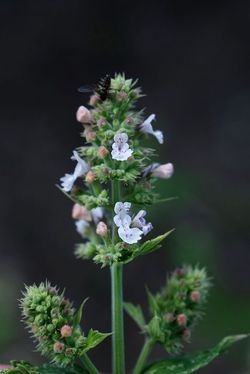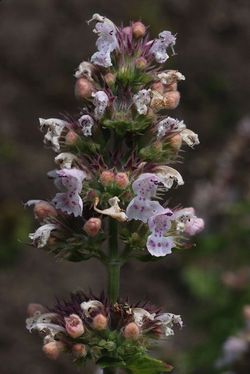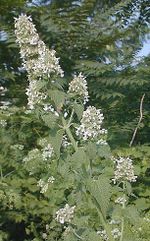Nepeta cataria
| Nepeta cataria |
|---|

|
| Scientific Classification |
|
| Binomial Name |
|
Nepeta cataria |
| Nepeta cataria |
The Nepeta cataria is a species of mint plant. It has many uses teas, soothing sore throats, and as catnip. It grows about three feet tall and is a herbaceous plant. It is indigenous to Europe and Asia but it has made itself at home. It grows and reproduces by other organisms like bees and butterflies. It maibnly grows summer months. It prefers the warmer weather of the south an is very common in Minnesota. It is a great plant to plant in your gardens or to have in your house, especially if you have pets yourself. it is amazing to see the creation God has made for us to enjoy on his green earth.
Body Design
Nepeta cataria can grow to 1 meter (3 feet, 3 inches) by .6 meters (2 feet) in good conditions. The flowers bloom from early July to late November, and the seeds are ripened from September to October. It grows in small individual stocks on the ground with leaves along the stem. The leaves contain chlorophyll and are mostly used by the plant to preforming photosynthesis (The process which plants and some other organisms use sunlight to synthesize foods). Leaves are generally heart-shaped or oval with a pointed tip, 1 to 4 inches long and up to 2 inches wide. The plant Nepeta Cataria is a hermaphrodite which means it contains the male and female reproductive organs. At the top of the plant is the cluster of flowers which contains the males reproductive organs(stamen), and the female reproductive organs(pistil). [1]
Life Cycle
Nepeta cataria is a perennial plant, which means it is a plant that usually live for two or more years. Its life starts off with a germinated seed which is dropped from the flower on to the ground. The seed then sprouts a small stem and roots. it grows and absorbs water and nutrients from the earth and through its roots. The leaves, which contains chlorophyll, also perform photosynthesis to obtain sugars from sunlight. Soon, after a few weeks it produces flower buds atop the flower. The flowers then bloom exposing the male stamen and the female pistil, ready for impregnation. The stamen hold the pollen which will be transported onto the pistil by either wind or water or other living organisms. The ovum is then ripe and will eventually drop off the plant to start the life process over again.
Ecology
Nepeta cataria is also known as catnip, is loved by many house cats around the world. Easily grown in average, dry to medium, well-drained soils in full sun to part shade. it is a plant that is very tolerant of droughts. Site plants in full sun in northern areas. Plants are somewhat intolerant of the humidity of the deep south, they appreciate shade of the evening. Wet soils in winter can be fatal. Easily grown from seed. Plants will self-seed in the garden, often profusely. It was originally from Asia ad Europe but has naturalized itself into North America and Canada. It attracts butterflies and bees for pollination.[2]
How it affects cats
Cats love catnip! They love to role in it, eat it. Although no one knows exactly what happens in the cat's brain, it is known that the chemical nepetalactone in catnip is the thing that triggers the response. Apparently, it somehow kicks off a stereotypical pattern in cats that are sensitive to the chemical. The catnip reaction is inherited, and some cats are totally unaffected by it. Large cats like tigers can be sensitive to it as well. The reaction to catnip only lasts a few minutes. Then the cat acclimates to it, and it can take an hour or two away from catnip for the cat to "reset." [3]
Video
cats getting a high from catnip http://www.youtube.com/watch?v=J5Xrcp6k8VE
References
- ↑ Radford, Amanda. Nepeta cataria - L. pfaf. Web. Sep 9 2009(update).
- ↑ Authorlastname, Firstname. Nepeta cataria Missouri Botanical Garden. Web. Date-of-publication or access (specify which).
- ↑ Authorlastname, Firstname. Page-Title http://animal.discovery.com/. Web. Date-of-publication or access (specify which).



